
HARDSCAPES IN THE GARDEN![]()
![]()
Motivation
![]() Why Natives
Why Natives
![]() Garden Goals
Garden Goals
Site Preparation
![]() Site Analysis
Site Analysis
![]() Site Plan
Site Plan
![]() Hardscapes
Hardscapes
Plant Selection
![]() Which Native
Which Native
![]() Planting Hints
Planting Hints
![]() Suggested Plants
Suggested Plants
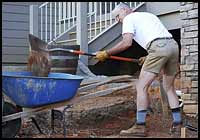
There will be a lot of shovel and wheelbarrow work to do.

You may find a source of free dirt for building mounds.
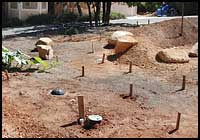
Stakes for marking pathways and planting beds are easy to trip over but useful if you need to leave them in place for an extended time. Hoses and rope work for temporary outlines.
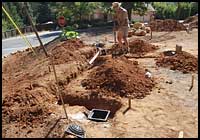
Taking photographs will help you remember how underground drain and water lines are positioned.
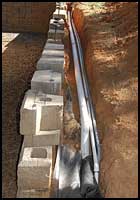
Drains, water supply lines and electrical conduits can be placed in the same ditch.
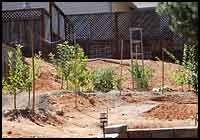
A home orchard can be planted in a smaller space than a traditional orchard if the owner uses summer pruning to control the size of the trees.
Hardscapes
Hardscapes include all the things on your site that are not living. In other words, hardscapes are structures such as terraces, berms, mounds, drains, walls, walkways, fencing, driveways, seating, water features, storage sheds, compost bins and so on.
Where to Start
Since there is much to accomplish before you can start planting, list an order of events and don’t expect to do it all at once. If you need to change the contours of the land, you will want to do that first. You may be moving dirt around, importing additional dirt and perhaps bringing in large decorative boulders and smaller rock for walls. Be mindful of your leach lines (if any) and avoid driving over them with heavy equipment. After slopes, terraces, mounds and berms are in place, you can install drains, water supply lines and electrical conduits. Hire professional advice and physical help whenever the tasks exceed your ability.
Lay Out Paths and Planting Beds
Using stakes, rope or a long hose, outline pathways and planting beds on the ground. You do not have to amend the soil for the plant beds, as unamended native soil is adequate for growing native plants. It is considered more effective to put mulch on top of the soil rather than mixing it in with the soil.
Install Water Supply Lines and Drains
You will need to water regularly during a native plant’s first two years in the ground. After that, the plant will need water once or maybe twice a month during the heat of summer. Although many plants will survive with no additional summer water, they will look better if they are given some. It is easier to have water piped nearby so you can extend drip lines rather than carrying water in a watering can or bucket. The watering system can be operated as needed or put on a schedule that will be modified as you observe the plant’s needs. If you are using drip, be sure to water long enough to soak deeply. As plants grow, you will need to expand the drip line around them to provide water for the expanding root zone.
Drain lines may need to be installed to carry water away from the house foundation and to avoid erosion. A current trend is to plant a “rain garden.” This is a low area where you can sequester excess water that will soak into the ground rather than run-off the property. You can grow moisture-loving plants here.
One Thing to Hurry
If you are planting fruit trees, one of the earliest things you should do is to designate their location and get the ground ready to take advantage of the first bare root season that you can, since it takes about four years for trees to start producing fruit. Follow the soil amendment suggestions of your local nursery. You might be interested in learning about the home orchard technique of planting fruit trees close together for successive harvest. The size of the tree is controlled through summer pruning. There are instructions at the Dave Wilson Growers website (see Links).